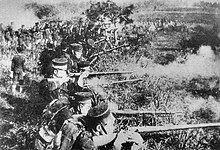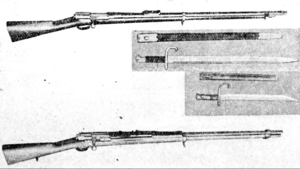You can help expand this article with text translated from the corresponding article in Japanese. (June 2022) Click for important translation instructions.
|
| Murata rifle | |
|---|---|
 Type 22 Murata repeating rifle Type 22 Murata repeating rifle | |
| Type | Bolt-action rifle |
| Place of origin | Empire of Japan |
| Service history | |
| In service | 1880–1919 |
| Used by | See Users |
| Wars | Donghak Peasant Revolution First Sino-Japanese War Boxer Rebellion Russo-Japanese War World War I Siberian Expedition Russian Civil War |
| Production history | |
| Designed | 1880 |
| Produced | 1880–1905 |
| Variants | Type 13 Type 16 carbine Type 18 Type 22 repeater Type 22 carbine repeater Experimental box magazine repeater Murata grenade launcher Civilian models |
The Murata rifle (村田銃, Murata jū) was the first indigenously produced Japanese service rifle adopted in 1880 as the Meiji Type 13 Murata single-shot rifle. The 13 referred to the adoption date, the year 13 in the Meiji period according to the Japanese calendar.
Development

The development of the weapon was lengthy as it involved the establishment of an adequate industrial structure to support it. Before producing local weapons, the early Imperial Japan Army had been relying on various imports since the time of the Boshin War, and especially on the French Chassepot, the British Snider-Enfield and the American Spencer repeating rifle. This was about 300 years after Japan developed its first guns, derived from Portuguese matchlock designs, the Tanegashima or "Nanban guns".
The combat experience of the Boshin War emphasized the need for a standardized design, and the Japanese Army was impressed with the metallic-cartridge design of the French Gras rifle. The design was invented by Major Murata Tsuneyoshi, an infantry major in the Imperial Japanese Army who had survived the Boshin War and subsequently travelled to Europe. Adopted in Emperor Meiji's thirteenth year of reign, the rifle was designated as the model 13 and went into production as the 11-millimeter Type 13 single-shot, bolt-action rifle in 1880. The original 11-millimeter Murata cartridge used an approximately 6-millimeter Boxer-type primer.
Superficial improvements such as components, bayonet lugs, and minor configurations led to the redesignation of the Type 13 to the Type 18 rifle in 1885. Further modifications in the same year involving both tubular and box magazines led to the Type 22 rifle, which used a tubular magazine and was reduced to caliber 8mm. The Type 22 was the first Japanese military rifle to utilize smokeless powder and entered military service in 1889.
The Murata rifle was accurate and mechanically reliable, and was noted for functioning well in cold weather. However, it suffered from relatively soft steel of mediocre quality. The bolt assembly in particular had a number of design flaws that necessitated frequent maintenance. It has been unfavorably described as a "poor man's Beaumont".
Three models of bayonets were produced for the rifles: Type 13 and Type 18 which were used with the single-shot variants and Type 22 which were compatible with the repeater variants.
Combat history

The Type 13 and 18 Murata rifle was the standard infantry weapon of the Imperial Japanese Army during the First Sino-Japanese War (1894–1895) and the Type 22 in the Boxer Rebellion. The Imperial Japanese Army was quick to recognize that the design of even the improved Type 22 version of the Murata rifle had many technical issues and flaws. Following the combat experience of the First Sino-Japanese War, a decision was made to replace it with the Arisaka Type 30 rifle, which had been designed in 1898, and which also used the more modern smokeless powder. The rifle performed well in any situation and terrain. However, due to insufficient production, many of the reserve infantry units sent to the front-lines during the latter stages of the Russo-Japanese War of 1904–1905 continued to be equipped with the Murata Type 22 rifle. Type 22s likewise continued to be used into the earliest stages of the First World War, though in very small numbers. After 1918, the Murata rifle had been retired, and many veteran rifles were sold onto the civilian market as hunting guns, in which capacity they still function as of the 21st century.
Filipino revolutionaries were looking for a possible purchase of weapons and the Murata rifle from Japan was usually proposed. This was to be acquired through arms smuggling under a supposed loan. There was some indication that unnamed personalities were arrested on suspicions of trying to acquire them from Japan.
Andres Bonifacio and Mariano Ponce sought to acquire Murata rifles via the Japanese silviculturist Nakamura Yaroku [ja] to equip the Katipunan in order to match the firepower used by Spanish and American colonial forces in the Philippines. The rifles were shipped from Japan with the approval of Kawakami Soroku on the Nunobiki Maru. However, the ship was destroyed in a typhoon off the coast of Taiwan.
While never serving in combat during World War 2, many conscripts of the Japanese Volunteer Fighting Corps were equipped with these and many other antiquated firearms.
Variants
| Murata Type 13 infantry rifle | |
|---|---|
 Murata Type 13 rifle (top) with Murata Type 22 carbine (bottom) Murata Type 13 rifle (top) with Murata Type 22 carbine (bottom) | |
| Type | Bolt-action rifle |
| Place of origin | Empire of Japan |
| Service history | |
| Wars | Donghak Peasant Revolution First Sino-Japanese War Japanese Invasion of Taiwan (1895) Boxer Rebellion Russo-Japanese War |
| Production history | |
| Designed | 1880 (Meiji 13) |
| Manufacturer | Koishikawa Arsenal Ogura Arsenal Nagoya Arsenal |
| No. built | Approx. 80,000 |
| Specifications | |
| Mass | 4.62 kg (10.2 lb) |
| Length | 1,294 mm (50.9 in) |
| Barrel length | 840 mm (33 in) |
| Cartridge | 11x60mmR Murata |
| Caliber | 11mm (10.97mm) |
| Action | Bolt-action |
| Muzzle velocity | 437 m/s (1,430 ft/s) |
| Maximum firing range | 1,800 m (2,000 yd) |
| Feed system | Single-shot bolt-action |
Murata Type 13 rifle (1880)
First model, single shot, 11x60mmR.
Murata Type 16 carbine (1883)
Derived from Type 13, structurally identical.
Type 18 rifle (1885)
Improved internal mechanisms and ergonomics.
Experimental box magazine repeater (1887)
Prototype for a box magazine version of the later repeater that was not adopted. Strangely marked in French "fusil à répétition Mourata à 5 coups année 1887". Five-round box magazine. Very similar to a proposed box-magazine conversion of the Winchester Hotchkiss.
Type 22 repeating rifle (1889)
Smaller caliber repeater. Tube magazine, capacity of eight rounds.
Type 22 repeating carbine (1889)
Carbine's magazine holds five rounds. Structurally similar to Type 22 rifle.
Murata grenade launcher
Some retired single-shot Type 13 and 18 Murata rifles were converted to fire rifle grenades. In this conversion, the rifling appears to have been removed. Experiments were also conducted with rifle-launched rockets.
Civilian models (various)
Usually retired Type 13s and Type 18s; commonly converted to bolt action shotguns via removal of bayonet lugs and rifling. A cut down stock was also common, though some civilian Murata rifles retained lugs, rifling, and old stock.
Users
 Empire of Japan
Empire of Japan Korean Empire: Japan supplied 200 Murata Type 13 rifles to the Korean government for the 80 Pyŏlgigun.
Korean Empire: Japan supplied 200 Murata Type 13 rifles to the Korean government for the 80 Pyŏlgigun. Republic of China: Some Type 13s used by various warlord armies, especially the pro-Japanese Fengtian Army.
Republic of China: Some Type 13s used by various warlord armies, especially the pro-Japanese Fengtian Army. Manchukuo: Used by second-line units and local constabulary forces
Manchukuo: Used by second-line units and local constabulary forces Mengjiang: Used by second-line units and local constabulary forces
Mengjiang: Used by second-line units and local constabulary forces White movement: Unknown number of Murata rifles supplied by Japan to anti-communist forces during the Russian Civil War
White movement: Unknown number of Murata rifles supplied by Japan to anti-communist forces during the Russian Civil War
See also
References
- ^ Zielinski, Stanley (2010). Japanese Murata Rifles 1880-1897 (1st ed.). Lodestone.
- "Japanese MURATA Type 13 (M.1880)". MilitaryRifles.com. 2008-08-28. Archived from the original on 2009-08-03. Retrieved 2009-07-19.
- ^ John Walter (25 March 2006). Rifles of the World. Krause Publications. p. 88. ISBN 9780896892415. Retrieved 12 March 2019.
- ^ Honeycutt & Anthony p. 8
- Honeycutt & Anthony p. 16
- Small, Charles; Warner, Ken (1983). "Murata Types 13 and 18". Gun Digest (1983 Annual): 196–199.
- ^ Kowner, Rotem (2006). Historical Dictionary of the Russo-Japanese War. Scarecrow. ISBN 0-8108-4927-5. p. 247.
- Affairs in the Philippine Islands. Hearings before the Committee. June 28, 1902. p. 1687.
- "From Four Nodes of History : The Human Rights Challenge in the Philippine Security Sector" (PDF). Philrights.org. Retrieved 12 March 2019.
- "DAILY STAR: TIGHT ROPE WITH MODESTO P. SA-ONOY". Visayandailystar.com. Archived from the original on 22 July 2015. Retrieved 12 March 2019.
- Fernando M. Reyeg; Ned B. Marsh (December 2011). "THE FILIPINO WAY OF WAR : IRREGULAR WARFARE THROUGH THE CENTURIES" (PDF). Apps.dtic.mil. Archived (PDF) from the original on August 5, 2019. Retrieved 12 March 2019.
- Matthiessen, Sven (2015). Japanese Pan-Asianism and the Philippines from the Late Nineteenth Century to the End of World War II: Going to the Philippines Is Like Coming Home?. BRILL. ISBN 9789004305724. Retrieved 25 October 2016.
- ^ Westwood, David (12 March 2019). Rifles: An Illustrated History of Their Impact. ABC-CLIO. ISBN 9781851094011. Retrieved 12 March 2019 – via Google Books.
- "[이일우의 밀리터리 talk] 조선총잡이로 본 '밀덕' 고종과 빵빵했던 대한제국군". 나우뉴스. 23 July 2014. Retrieved 2022-02-08.
- Chinese Warlord Armies 1911–30 by Philip Jowett, page 22.
- Jowett, Philip S. (2010). Rays of the rising sun : armed forces of Japan's Asian allies, 1931-45. Vol. 1, China & Manchukuo. Helion. p. 15. ISBN 9781906033781.
Bibliography
- Honeycutt, Fred L., Jr., and Anthony, Patt F. Military Rifles of Japan. Fifth Edition, 2006. Palm Beach Gardens, Fla.: Julin Books. ISBN 0-9623208-7-0.
External links
- Type 18 Murata Forgotten Weapons
| Preceded byTanegashima Matchlock Imported Rifles |
Imperial Japanese Army Service Rifle 1880–1905 |
Succeeded byArisaka |